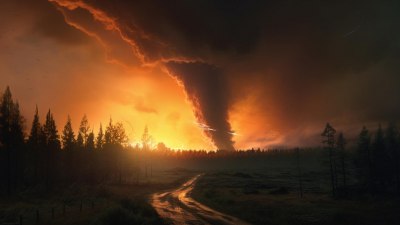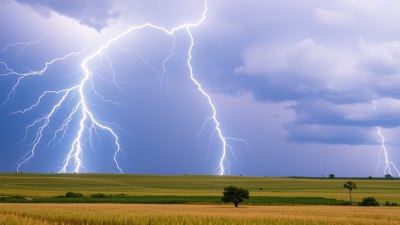What Causes Morning Fog to Vanish as the Sun Climbs
Explore the science behind morning fog and its dissipation as the sun rises.

Morning fog is a natural phenomenon that can create stunning visuals during dawn, but it’s also a complex interplay of meteorological factors. As the sun rises, the fog appears to dissolve, leading many to wonder: what causes this transformation? In this article, we will delve into the science behind fog, its formation, and the factors leading to its dissipation as the sun climbs higher in the sky.
Understanding Fog Formation
Fog is essentially a cloud that forms at ground level, consisting of tiny water droplets suspended in the air. It typically forms when the temperature drops to the dew point, leading to saturation of the air. There are several types of fog: radiation fog, advection fog, upslope fog, and evaporation fog, each with distinct causes and conditions of formation. Radiation fog, which is the most common type associated with morning fog, occurs on clear nights when the ground cools rapidly, chilling the air above it. If the air cools sufficiently, it can reach the dew point and condense into tiny droplets that create a dense fog cover.
Temperature and Humidity Factors
Temperature plays a crucial role in the formation and dissipation of morning fog. As the sun rises, it emits radiation that warms the ground and the air above it. This warming process directly influences the relationships between temperature, humidity, and saturation. Initially, the cool air trapped beneath the fog can hold moisture well, contributing to its density. However, as temperatures increase, the capacity of the air to hold moisture rises, and evaporation begins to occur. The humidity decreases as the temperature rises, reducing the likelihood of condensation and leading the fog to dissipate.
Solar Radiation and Infrared Heating
The role of solar radiation is vital in the dissipation of fog. As the sun rises, its rays penetrate the atmosphere and reach the ground. The ground absorbs this solar energy, heating the surface air above it. This process is known as convective heating. When the ground temperature increases, it warms the cooler air in contact with it. Consequently, the density of the fog decreases as rising warmer air becomes less conducive to moisture retention. The solar energy also drives the process of evaporation, transforming the solid water droplets in the fog back into vapor and causing the fog to lift and dissipate.
Changes in Wind Patterns
Wind patterns can also influence the dissipation of fog. As the sun rises, the difference in temperature between the land and surrounding areas can create pressure variations. These variations can lead to wind patterns that assist in mixing the air. Increased mixing can break up the dense fog layer and disperse the moisture more effectively. Additionally, if winds shift from being calm to a light breeze, the movement can enhance evaporation rates and contribute to the fog's dissipation.
Geographical Factors and Topography
The geographical location and topography of an area can significantly affect how fog behaves in the morning. Regions close to large bodies of water tend to experience higher humidity levels, which can lead to persistent fog conditions. In contrast, areas with higher elevations may see increased dissemination of fog as the sun climbs due to changes in temperature gradients and wind patterns. Valleys can also trap cool air, keeping humidity high during sunrise, causing fog to persist longer. Conversely, hillsides and mountainous terrains can experience quicker dissipation as these regions warm up more rapidly due to increased solar exposure.
The Role of Atmospheric Pressure
Atmospheric pressure is another factor that can affect fog formation and dissipation. High-pressure systems are typically associated with clear skies and stable conditions, while low-pressure systems can lead to cloudier and potentially rainier conditions. During high-pressure episodes, the humidity levels decrease as the ground warms and the air becomes drier. This shift promotes the evaporation of fog, assisting in its dissipation as sunlight becomes more intense. In contrast, during low-pressure situations, fog can remain longer due to higher moisture levels in the air and potentially cooler temperatures.
Cloud Cover and Weather Conditions
Cloud cover can also play a role in the dissipation of morning fog. When clouds are present, they can block some of the sun's rays, leading to a cooler environment that maintains fog conditions longer. In these scenarios, the interaction between cloud cover and fog can create a unique weather pattern, delaying the fog's dissipation until clouds begin to clear, allowing for increased solar radiation to impact the ground. In contrast, clear skies generally accelerate the warming process, resulting in quicker evaporation and a more rapid disappearance of fog.
The Role of Dew Point and Relative Humidity
The dew point is the temperature at which air becomes saturated with moisture, leading to the formation of dew, fog, or clouds. A crucial factor in fog dissipation is the relationship between the air temperature and dew point. As the sun rises and the temperature rises above the dew point, the air's ability to hold moisture surpasses the moisture present in the atmosphere, leading to decreased relative humidity. This change results in the fog beginning to evaporate as the conditions become less favorable for condensation. Understanding this relationship helps explain why fog can rapidly form and dissipate with minimal temperature fluctuations.
Localized Effects and Microclimates
Microclimates are localized zones where the climate differs from the surrounding area, often due to variations in vegetation, topography, or water bodies. These localized effects can lead to the formation of fog-rich areas that may not dissipate as quickly as their surroundings. Conversely, specific microclimates may experience rapid warming, leading to faster fog dissipation. For instance, areas with dense vegetation may retain moisture longer, and when combined with sunlight, this can create an environment for extended fog visibility. The balance between local environmental factors and broader atmospheric conditions can create unique scenarios for fog formation and dissipation during the early morning hours.
The dissipation of morning fog as the sun climbs higher is a fascinating intersection of physics, meteorology, and geography. As temperatures increase, humidity levels drop, and atmospheric dynamics shift, fog gradually transforms into vapor and ceases to exist. Understanding the core principles behind this phenomenon not only satisfies our curiosity about nature but also emphasizes the intricate connections within our atmospheric systems. Next time you witness the beauty of morning fog, remember the intricacies at play that contribute to its transience.











